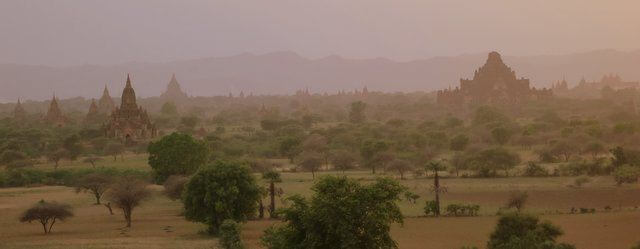
A dusty Bagan sunset
Visa Requirements
Most nationalities require a visa for Myanmar. These can be arranged through any Myanmar embassy or consulate worldwide. I got mine in Beijing (after briefly visiting the very similar looking Afghanistan embassy next door), which took two passport photos, 200rmb ($30) and five working days to process.
Guide Books
It was impossible to find an up to date English language guide book for Myanmar in Beijing, so we used a Lonely Planet Myanmar guide book from 2005. It was fine with explaining history, especially in places like Bagan where everything is 1000 years old. If I were travelling independently I’d like a more recent guide book, but everything is changing so fast I’m not sure how useful it would actually be. Plus getting lost and trying new places or asking for recommendations is all part of the fun.
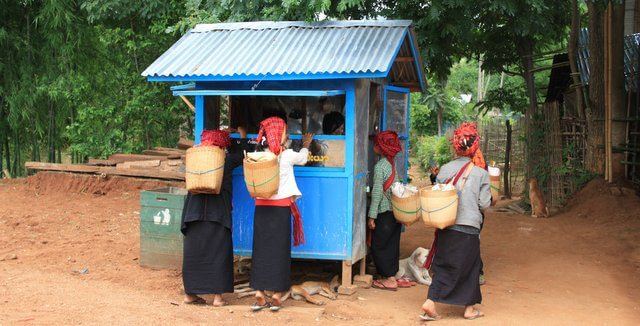
Kiosk in Myanmar selling betel nut wraps to give energy to the workers
Tour agencies and prices
It seems quite straightforward to move around Myanmar under your own steam, but for the sake of brevity we’d paid an agency to make all the bookings. This means you still do all the planning, but they take care of the booking and transportation.
I used an online form that queried a large number of tour agencies: http://www.myanmars.net/myanmar-travel/tour.information.htm . It’s a handy tool, but be wary that my one query generated over 30 response emails and a lot of follow-ups, so it’s best to only apply when you’re clear exactly what you want.
From the itinerary I’d outlined we were quoted between £4000 and £900 for the same route in the same hotels. The price went down the longer we waited.
In the end we used Ko Tar Travels. They were at the cheaper end of the quotes as we didn’t want a full-time English speaking guide, and we were very happy with them apart from a hiccup at the Golden Rock.
It’s not possible to transfer money into Myanmar electronically, so they booked everything on trust and we paid when we arrived.
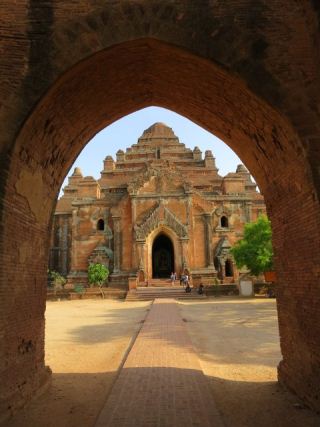
Our first glimpse of Dhammayan Gyi
Time in Myanmar
Local time in Myanmar is GMT +6.5 hours.
Travel Money
Myanmar is very specific about its money.
Money changers only accept US$100 bills. Other currencies are very hard to change.
The $100 bills cannot have any creases or smudges, no matter how slight. Finding these in China was tricky. HSBC refused us new notes, despite them having plenty. Bank of China was far more accommodating – the teller went out the back to get a stack of new notes and carefully checked each one before giving them to us in a stiff envelope.
Changing Travel Money
It used to be far more desirable to change money at the market in Yangon to get the best exchange rate, but now it’s better to get your kyat at the airport. The exchange rate is fixed and you’re unlikely to get old or even fake notes.
We used the kiosk next to the café and they were very good about giving us a selection of denominations.
Tourist Fees
Most tourist sites offer prices in kyat and dollars. It’s usually 25% cheaper to pay in dollars, but change is hard to procure. Keep a large pile of US$1 and $5 bills in reserve.
Many tourist sites have camera fees of 300kyat. Photographic cameras and video cameras are charged separately, but only once for a camera with a video function.
The international airport has a departure fee of $10. Keep enough pristine dollar bills to pay this.

Boat on the Ayarwaddy River
Climate and Clothing
March to mid-May is the hot season. Mid May to October is the rainy season. The cool season is from mid-October until February.
We went during the quiet rainy season, when there were barely any other tourists. Temperatures were still 40C and very humid, but it only rained for a couple of hours in total.
Light clothes are fine all year round, but remember to be discrete at temples. Shoulder-bearing tops, miniskirts and short shorts may get you denied access to some temples.
Travelling Within Myanmar
Domestic flights are $60-$100. They operate on a bus schedule, which can be confusing to the first time traveller.
Buses, taxis and trishaws all make use of the well maintained new roads between major towns.
Eating
Food there is excellent. See this post on curry and other dishes.
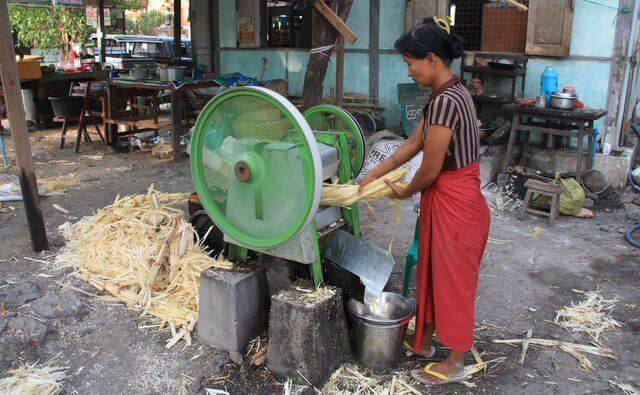
Making sugar cane juice in Mandalay
Sugar Cane Drink
A mention for my favourite drink in Myanmar. Sugar Cane juice is simply a sugar cane or two passed through a mangle and served with ice and limes.
Despite all the warnings we didn’t get ill at all from drinking so much ice. Similarly all the warnings about avoiding the toxic meat and becoming temporarily vegetarian were pointless. The only time I got ill was when the only choice was between three vegetarian restaurants, and I was poisoned by a lentil wrap.
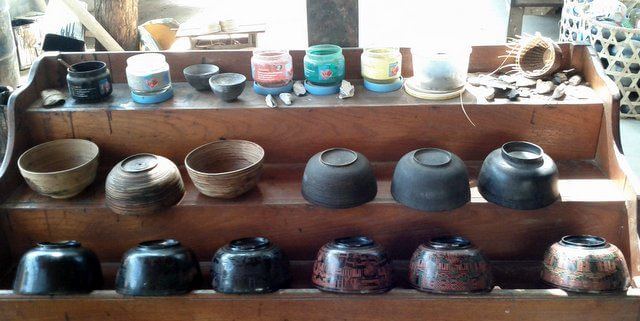
The various stages of Lacquer ware production in Bagan
Shopping
Popular items are jade from Yangon (make sure you get an official receipt) and lacquer ware from Bagan. Wood carvings and hand-made monks umbrellas are popular everywhere.
Haggling is expected and necessary for anything beyond food.
Internet
There’s no mobile internet in Myanmar, so roaming doesn’t work. Wi-Fi is widely available, but so slow as to be unusable. After a couple of days suffering withdrawal I really enjoyed being completely unconnected for a couple of weeks. H tried an internet cafe in Mandalay and it worked but was too slow for much more than checking email.
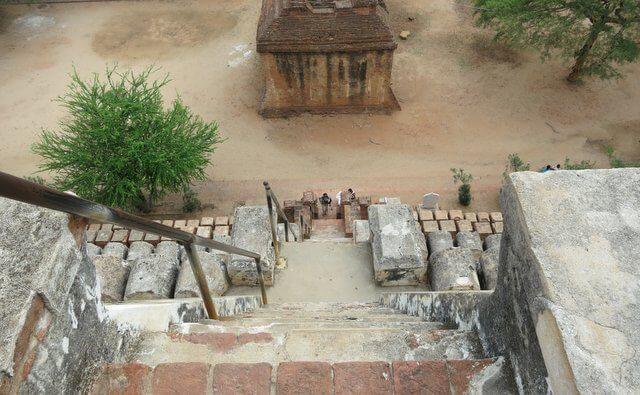
Bagan temple stairs – be prepared for a lot of climbing!
Health & Safety
There is minimal crime in Myanmar. Our driver happily left his keys and wallet on the dashboard as we walked around.
No immunisations are required, but malaria might be wise if you’re heading to the jungle areas. Don’t drink the tap water! All hotels we visited offered lots of free bottles of filtered water.
Sunscreen is necessary under the tropical sun, especially in Inle Lake and Bagan.
Power Cuts
Power cuts occur daily. Often these are scheduled, so everyone in the outlying villages gets a turn with the power. More often they’re unscheduled so I don’t get a turn in the shower.
Another tip is to take a small torch. Larger hotels may provide one.
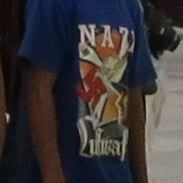
Nazi Luftwaffe t-shirt at the Shwedagon Pagoda
Nazi and Luftwaffe t-shirts
Not a shopping tip! Just a note that kids everywhere are wearing clothes with German military themes. I’d have thought that people here surely remember the war, and aren’t confused by the swastikas.
Either that or some enterprising far-right t-shirt company has offloaded a bulk lot of unsold t-shirts to the unsuspecting far-East.
Taxis
Taxis are very friendly and very cheap, with few city journeys costing over 2000kyat. Despite many opportunities to cheat or steal from us whilst we were distracted by the sights and sounds of Myanmar, they were unwaveringly honest.
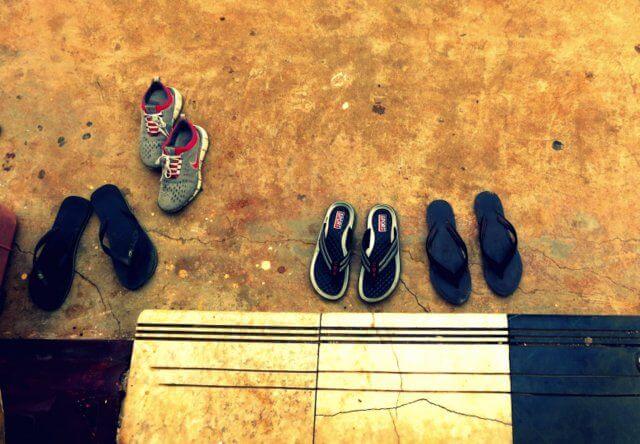
Take off your shoes
Wear Flip Flops
The handiest tip is to wear flip-flops. Whilst this was obvious to everyone else, I wore trainers the first day and it got annoying. Everyone is wearing flip-flops as footwear is taken on and off dozens of times a day entering temples, monasteries, homes, everywhere.
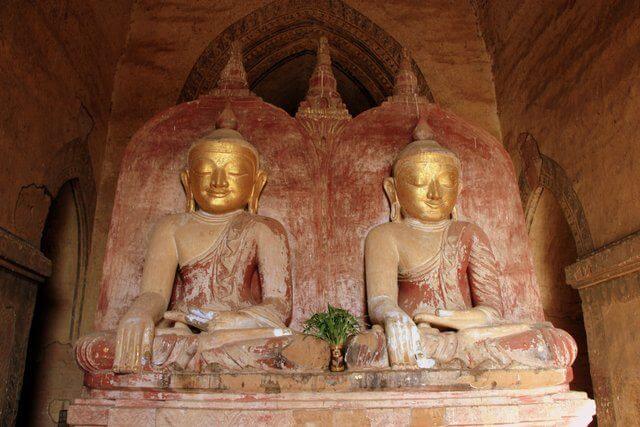
Double Buddha statue in Bagan
Finally, have fun
Myanmar is one of the most beautiful and most welcoming places I’ve visited. Go now, before it is changed too much by tourism. You really can’t fail to have a wonderful time there.






Some good tips and Mayanmar is one country where you really need to do a little research before going, mainly because of the money situation. I always wondered how many people have shown up without the required pristine US dollar notes and have basically been broke.
It’s nice to know that the airport rates have become more realistic. When I was there they were horrible and we were pretty much forced to use the money changers. We didn’t have any problems though, other than the strange feeling of walking around with a huge back full of bricks of money.
If that happens and you’re broke, or even just short of cash, the only hope is to go to one of the 5* hotels in Yangon. They’ll give a cash advance on your credit card for an appalling exchange rate and a painful 30% commission.
Pingback: @ajggentozala
Pingback: @aepulay
Pingback: @AvaApollo
Thanks for all of these really helpful tips! My husband and I are currently in southern China, and while we aren’t 100% sure we will visit Myanmar, it is on the list of places we would definitely like to visit while in this part of the world if we can.
A question about money: as we came from the States, we thought to bring some U.S. cash with us, just in case, including some pristine $100 bills. But the rest of the money we brought is not pristine… if we go to a bank in China (or Thailand), could we exchange those for pristine bills?
Also, how much, on average did you spend per day in Myanmar? As you said, it seems like it would be a bad idea to show up with not enough funds as the only way to get cash is through credit cards, which is always a last resort! And it seems like working in U.S. currency is the best way to go, so how much did you exchange for the local currency?
Hi, I really think that Myanmar is worth visiting as soon as possible, as tourism is rapidly changing the place – the effects can be seen already in the water villages at Inle Lake.
Bearing in mind that we had pre-paid an agency $1200 for the hotels and private transport, for two weeks we spent around $800 (in kyat) on food, drink, camera fees, local taxis, donations and small souvenirs, plus another $100 (in small denomination dollars) on entrance fees and permits. The bulk of the expense was food, and we could have gone much cheaper, but a couple of our hotels (Inle Lake & Kalaw) were in the middle of nowhere, so we had to eat the expensive (and slightly dull) hotel food.
If you go to Bagan in peak season the hot-air balloon rides are around $200-250 per person, paid in dollars. More expensive souvenirs such as jade or lacquerware were always priced in kyats, but they wanted to be paid in dollars.
A bank in China will generally be quite understanding if you mention Myanmar – Bank of China or China Merchants Bank are the most likely to have English speaking staff.
Pingback: @AvaApollo
Hi! I found your set of tips really interesting, as I went to Myanmar last year and am about to go back. I’m definitely gonna look out for the Nazi t-shirts – weird. I saw a restaurant in Pokhara city, Nepal called “Hitler’s Cross” – what the. I’m intrigued by your experience of the food – (read your other post, too.) Pretty much all my meals were below average – mind you, I am vegetarian so a lot less choice. By the way – where were the three vego restaurants?
The three vegetarian restaurants were opposite Tharabar Gate in Bagan, where we watched the sunset. One had a StarBucks logo and was called was called Star Beans. That tended to be a little brightly lit, so we went to the ones on each side. Most of the time we just asked drivers to take us to truck stops/drivers cafes, where and the food was very cheap, tasty and had a high turnover. They often had lentil side dishes, but very few dedicated vege options.
The area around U Beins bridge in Amarapura was another good place for spotting the unfortunate Nazi shirts.
Pingback: @TravelM_ag
This is excellent! I probably won’t make it to Myanmar anytime soon, but it’s really exciting to see more and more tourists visiting there and sharing their experiences, especially with all the negative attention the country has received over recent years. Very thorough guide. Thanks!
Nicely done. Good to read a review and advise that shows more than one side to a place. Love the photos too – rich compositions there.
I was in Myanmar a week after you. The money thing is quite true, a bellboy would not take a ONE DOLLAR bill that was not perfect. Your readers can check out my posts in http://theothersideofthecoconut.com for tips derived from my irreverent views!!
Pingback: Gear Up and Play (@gearupandplay)
Pingback: Dr. Jessica Voigts (@WanderingEds)
Thanks for the great tips here! Very helpful. Myanmar with probably change a lot in the coming years, given the heavy Chinese investment in infrastructure in the country (probably for oil and gas reserves, I’m guessing).
Thank you so much for this article; it was at once both intriguing and informative. It is definitely a place I would love to visit, and now I feel I would be a little more confident doing so, thanks to your words of advice. My dream would be to do the Ballons over Bhutan – if you might like to read our post, here’s the link to my story from last year: w.newjetsetters.com/exotic-hot-air-ballooning-in-asia/. Hope to see you there! Happy Travels, Deborah.
I’m going there in January. Really can’t wait.
Thanks for the post, really helpful in my preparations.
Let me know if you have any other questions – Have a great time
Great article! Myanmar is certainly a country that requires planning and research beforehand! I found that particular research in to traveling within Myanmar was necessary….especially the confusing bus timetables!! (On the subject of transportation I absolutely must suggest taking a horse and cart around Bagan – helps a local and allows you to take little back roads where other tourists can’t go by car).
Myanmar is a land where time has stood still it seems, it’s part of its charm certainly, but it has to be said that WiFi is getting a lot better; a large restaurant and coffee shop called My Garden offers what seems to be the fastest WiFi in Yangon! Moreover the chance of finding an ATM is on the up, I even found this site that actually details a few places you can find an ATM: http://www.myanmarburma.com/en/pages/content/4?mid=9&cid=1 progress!!!! Perhaps the days of taking big wads of cash with us could fade soon!
Good to know there’s a few more ATMs popping up!